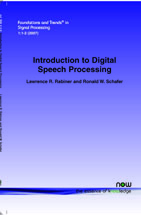Introduction to Digital Speech Processing
By Lawrence R. Rabiner, Rutgers University and University of California, USA, rabiner@ece.ucsb.edu | Ronald W. Schafer, Hewlett-Packard Laboratories, USA
Abstract
Since even before the time of Alexander Graham Bell's revolutionary invention, engineers and scientists have studied the phenomenon of speech communication with an eye on creating more efficient and effective systems of human-to-human and human-to-machine communication. Starting in the 1960s, digital signal processing (DSP), assumed a central role in speech studies, and today DSP is the key to realizing the fruits of the knowledge that has been gained through decades of research. Concomitant advances in integrated circuit technology and computer architecture have aligned to create a technological environment with virtually limitless opportunities for innovation in speech communication applications. In this text, we highlight the central role of DSP techniques in modern speech communication research and applications. We present a comprehensive overview of digital speech processing that ranges from the basic nature of the speech signal, through a variety of methods of representing speech in digital form, to applications in voice communication and automatic synthesis and recognition of speech. The breadth of this subject does not allow us to discuss any aspect of speech processing to great depth; hence our goal is to provide a useful introduction to the wide range of important concepts that comprise the field of digital speech processing. A more comprehensive treatment will appear in the forthcoming book, Theory and Application of Digital Speech Processing [101].
An Introduction to Digital Speech Processing
Introduction to Digital Speech Processing highlights the central role of DSP techniques in modern speech communication research and applications. It presents a comprehensive overview of digital speech processing that ranges from the basic nature of the speech signal, through a variety of methods of representing speech in digital form, to applications in voice communication and automatic synthesis and recognition of speech. Introduction to Digital Speech Processing provides the reader with a practical introduction to the wide range of important concepts that comprise the field of digital speech processing. It serves as an invaluable reference for students embarking on speech research as well as the experienced researcher already working in the field, who can utilize the book as a reference guide.
